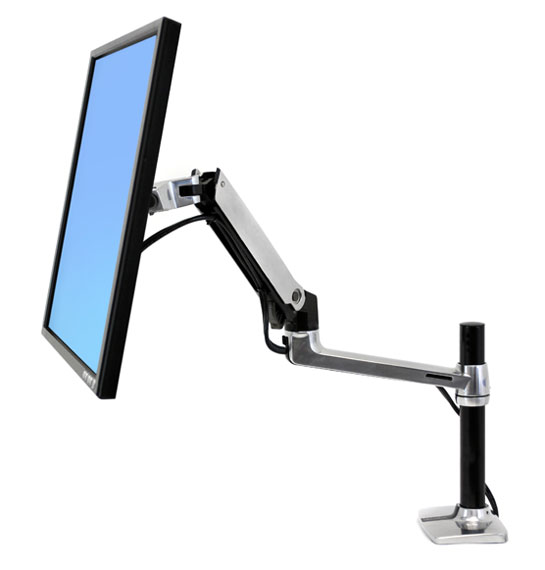 Sitting in front of a computer display all day long does not do wonders for your health.
Sitting in front of a computer display all day long does not do wonders for your health.
Things are made considerably worse if that computer display is of the notebook kind. Laptops in general are ergonomic nightmares putting your body into all the wrong positions. First, you need to look down all day long, then to make matters worse, the keyboard is attached directly to the screen forcing you to find the least bad compromise between positioning your arms and hands correctly and getting the screen into a semi-comfortable viewing position. Unfortunately no good compromise exists and you will over time do both your upper extremities and your neck/ back/ shoulders in. If it feels a little uncomfortable now, trust me, it’ll hurt a few years down the line.
Desktop computers are much better in that regard, allowing you to independently adjust keyboard, mouse and display. Unless you are using an iMac of course. Its aesthetics-over-function design has led everybody’s favourite industrial designer, Johnny Ive, to give it a stand that is far too low to allow you to view it comfortably. Such a shame because his Luxor Junior-inspired second generation iMac featured what must surely have been the best built-in monitor arm ever.. Oh Johnny..
When it comes to ergonomic Macs then, it’s a choice between the Mac Pro (my choice), the Mac mini (also my choice) or the newish VESA-mounted (stand-less) iMac.
On this type of setup you can not only choose your own (non-glossy if you want it to be easy on your eyes) display(s), but also adjust its height, distance from your eyes and inclination to your heart’s content.
The “ideal” viewing position is usually said to be at least 30cm (circa 12 inches) from your eyes, with the top-most row of pixels level with your eyes. A very slight forward tilt to the monitor is also said to be beneficial.
I find that advice to be fairly close to what I find comfortable myself, even though it’s better still to slightly raise and lower the display every now and then.
Monitor arms allow you to reach this position very easily and make adjusting it much less painful, though even the best monitor arms are not quite as good as the one on that second generation iMac. Monitor arms also free up space under the monitor and make for a much tidier setup over all.
I personally own several Ergotron LX Desk Mount Tall Pole mounts and they are great. They can be fixed directly through a screw onto your desk and once installed are much steadier than their admittedly much cheaper counterparts. They are sturdy and easily set up correctly and can be adjusted within a very large range of distances and heights. Moreover they work great in multi-display setups.
I’m fairly tall (6 feet 4) and I find that having the display slightly higher than is usually recommended is most comfortable for me. Most monitor arms do not stretch high enough for me and the Ergotron LX’s tall pole to which the arm itself is attached allows for raising the displays as high, and indeed higher than is comfortable. Anyway it’s better to have more range of adjustment than you need than to have just that little bit too little.
I also use a sit/ stand desk in my home office and unfortunately even the tall pole version of the LX, does not go high enough to cope with the standing position.
In theory, you shouldn’t have to adjust the height of the screen at all when your desk goes into the standing position. When you are sitting at your desk, you are holding your upper body completely straight just as if you were standing! Or at least that’s what the theory says.
In practice, my merely-human body isn’t candle straight at all times but likes to move around, lean forward, then back, etc. When I stand up I find that the screen is too low for comfort and it needs adjusting upwards. The Ergotron LX Sit/Stand Monitor Arm gives you jumbo-sized adjustability and takes even heavy weight monitors. I originally got those for my twin 30″ Apple cinema displays that showed their age through their ludicrous weight. One of them now has my Dell UP3214Q 4K display monitor on it, while the other supports a Dell UP2713HM; both awesome displays in different price ranges and weight categories.
Designed to be used to easily lift a monitor from a sitting to a comfortable standing position without the desk itself moving, the sit/stand version of the Ergotron easily deals with the comparatively small task of lifting the monitors that extra bit higher. The sit/stand version is clearly overkill but in a good way. It’s much more stable and paradoxically moves much more easily with even heavy loads. Not cheap but highly recommended, even in combination with a sit/stand desk.
Monitor arms seem like an indulgence to most people, but the cost of an ergonomic setup is dwarfed by the cost of wasted productivity and the inevitable medical bills that accumulate after a decade or two of full time screen-based work. For a home-based full-time IT professional like myself there really should be no hesitation in splurging out on a proper setup.
